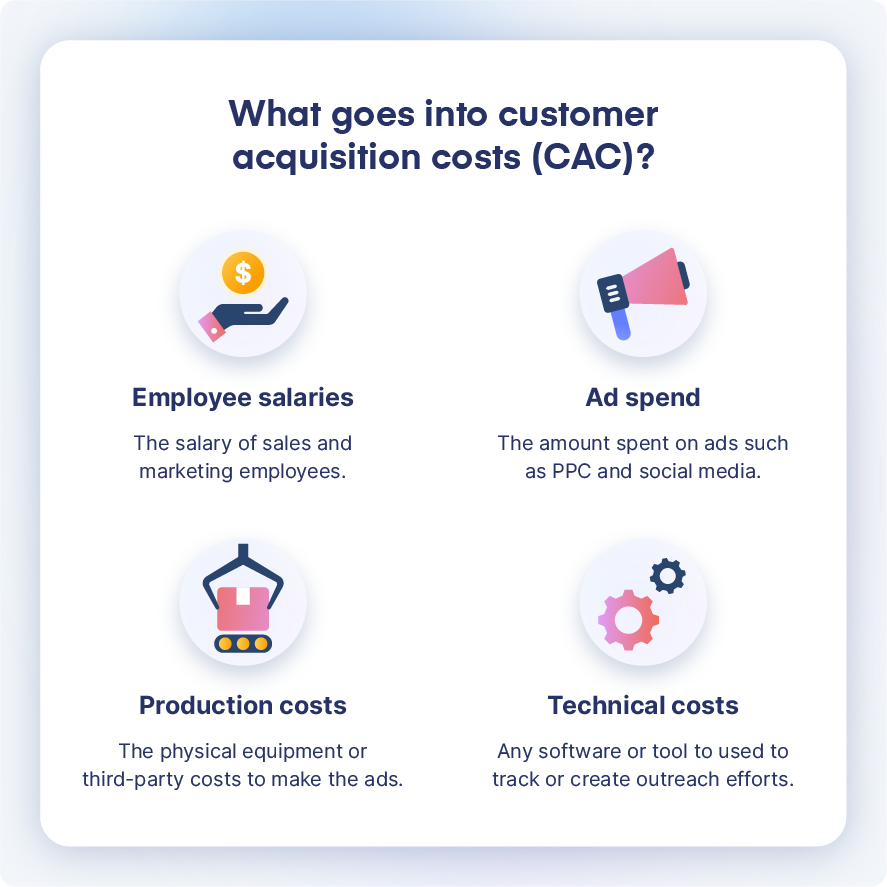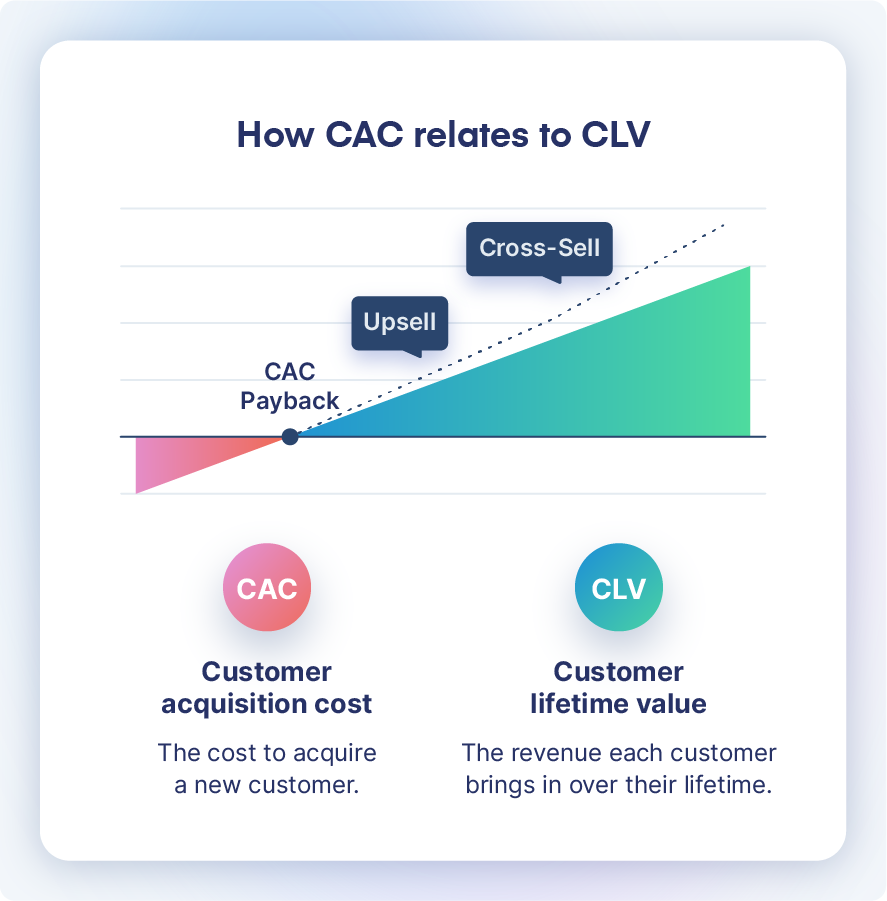What is customer acquisition cost (CAC) and how to calculate it
For a business, understanding customer acquisition costs is key to having strong, relevant outreach.
Customer acquisition costs (CAC) are the total costs for a company to acquire a new customer. This can range from not only the cost of ads, but also anything associated with advertising like equipment and salary costs. Without a full understanding of this financial concept, businesses may be doomed to low-performing advertising and inefficient spending.
In this article, we will detail everything you need to know about customer acquisition costs from how to calculate it, how customer lifetime value can influence CAC decisions, and how to optimize ad channels to get the largest ROI possible on your outreach efforts.
What is customer acquisition cost (CAC)?
Customer acquisition cost (CAC) is the total cost it takes for a business to gain a new customer. This metric includes marketing oradvertisements costs as well as other “behind-the-scenes” expenses such as payroll and production costs.
CAC is a relatively new metric due to businesses now being able to hyper-focus their marketing efforts. In the past, marketing involved casting a wide, calculated net in the hopes of achieving an acceptable return on investment (ROI). Now, businesses can individually optimize their campaigns to target specific market segments as efficiently as possible.
This concept is important for a business because it measures the effectiveness of marketing efforts. The goal is to have the lowest customer acquisition cost possible, and a CAC that is too high compared to previous quarters or industry standards can signal marketing messaging that misses the mark with consumers.
Without a solid grasp of customer acquisition costs, a company may be burning their advertising budget and sinking valuable resources into sub-optimal campaigns that don’t convert efficiently.
What costs go into CAC?
Customer acquisition costs include all of the expenses associated with gaining a new customer, not just the advertisement or outreach effort itself. Here are a few common expense categories that go into CAC.
1. Employee salaries
If an employee is involved in sales or marketing, their salary is part of customer acquisition costs.
These are the individuals in an organization that create, track, and optimize outreach efforts, so it’s only natural that their wage and any company-sponsored trainings are included in CAC. This is also why it’s important for a business to find and cultivate talent in these departments—highly skilled sales and marketing employees can add a large amount of value to an organization both in customer acquisition and ROI.
2. Ad spend
Ad spend is the amount of money that a business directly spends on advertising.
This expense includes advertising from all mediums, be it PPC ads, social media ads, or more traditional ads like magazine ads or direct mail campaigns. If a business engages in multiple forms of advertising, it would be wise to separate these costs to examine individual campaign performance.
3. Production costs
Production costs include anything needed to physically produce the advertisement. This can include equipment, or the cost to hire a third party.
For example, Business A wants to film their own social media advertisement. They purchase a camera, lights, and set design: All of this equipment would be included in production costs.
On the other hand, Business B would rather contract a third party to produce the ad for them. Even though they aren’t purchasing equipment, they will still pay for production, so the cost to hire a third party would fall under the production cost umbrella as well.
4. Technical costs
Another common expense included in CAC is technical costs, which is the software that the sales and marketing departments use to create, track, and optimize outreach efforts.
This can be analytics software, creative software, or marketing software to identify, compile, and capitalize on warm leads.

How do you calculate customer acquisition cost?
You can calculate CAC costs with the following formula:
CAC = GTM spend / Number of customers acquired
In this equation, go-to-market (GTM) spend refers to all of the costs we’ve previously touched on: employee salaries, ad spend, production costs, and anything else directly associated with the sales and marketing departments. When you establish this figure, divide it by the total number of customers acquired in a specified time period.
If an organization would like to go deeper into CAC analysis, they can break CAC down into two subcategories: marketing CAC and advertising CAC.
Marketing CAC = Marketing spend / Number of customers acquired
Advertising CAC = Advertising spend / Number of customers acquired
Analyzing marketing and advertising CAC separately can give an organization insight into how each section is performing, and the ability to hone in on specific areas of improvement if needed.
What are examples of customer acquisition costs?
Now that we have outlined the principles of CAC, let’s take a look at a fictional example to see how this concept works in practice.
Gym Sloth Clothing ran paid advertising campaigns over the past year and wants to analyze its customer acquisition costs. During the indicated 12-month period, they identified the following expenses:
- Salary expense: Gym Sloth employs four sales and marketing employees at a rate of $60,000 per year.
- Ad spend: The company spent $2,500 per month on social media advertisements, $5,000 per month on PPC campaigns, and $7,500 total for three months of newspaper advertising.
- Technical costs: For analytics and other marketing software, Gym Sloth paid $500 per month.
- Production costs: Over the course of the year, they spent $50,000 for the equipment—and sometimes, third-party hiring—to produce the advertisements.
A quick numbers analysis may look something like this:
Gym Sloth Customer Aquisition Costs (CAC)
- Sales and marketing salaries: $240,000
- Advertising expenses: $97,500
- Technical costs: $6,000
- Production costs: $50,000
- Total GTM spend: $393,500
- New customers: 5,479
- Total CAC: $71.81
With a total GTM spend of $393,500 for the year, and 5,479 new customers acquired, Gym Sloth had a $71.81 customer acquisition cost for the given time period. Whether that number is good or bad for their business depends on a number of key factors, one of which is customer lifetime value.
Customer lifetime value (CLV) vs. CAC
While CAC is an extremely important metric when evaluating the effectiveness of outreach campaigns, it isn’t the end-all-be-all of numerical analysis. Once you establish a customer acquisition cost, it’s important to compare it to customer lifetime value.
Customer lifetime value (CLV) is the projected revenue that each customer will bring in during their lifetime relationship with the company. This can include factors such as the length of the relationship, how much money a customer spends on average, the business’ profit margin, and a host of other relevant metrics specific to each business.
The formula for CLV can be expressed as:
Customer lifetime value (CLV) = Customer value X Average customer lifespan
[Customer value = Average purchase value X Average amount of purchases]
The important thing to note is that a business cannot get a full picture of CAC without comparing it to CLV.
Let’s take another look at Gym Sloth from the example above. Over the previous year, this fictional clothing brand brought in 5,479 new customers for a total CAC of $71.81. Now, that number on its own can be analyzed by Gym Sloth to compare similar outreach campaigns, but to truly understand if $71.81 is a “good” or “bad” number is to compare it to CLV.
A widely-accepted golden ratio for CLV to CAC is 3:1—in other words, a customer should bring in at least three times as much money as it cost to acquire them.
So, for example, if Gym Sloth’s LTV is $218.59, they should be satisfied with their CAC of $71.81 as that’s roughly a 3:1 ratio. However, if their CLV is lower—say, $172.69—that is under a 3:1 ratio, and their outreach efforts should be scrutinized and optimized.

How do you lower CAC?
If your organization finds itself below that golden 3:1 CLV to CAC ratio, all hope is not lost. Here are a few implementations you can make to lower your customer acquisition cost.
1. Improve customer acquisition methods
If your CAC is suffering, perhaps it’s time to dig into your organization’s acquisition methods.
Take time to evaluate the effectiveness of outreach across all channels. You may find, for example, that social media marketing brings in a paltry amount of new business compared to overall ad spend—perhaps you find a way to improve that method or scrap it altogether. Or, you may find PPC is an extremely cost-effective way of bringing in new customers for your business—you might want to double down on those efforts.
Additionally, you could recruit the help of tools and software to improve your customer acquisition efforts like Clearbit Capture.
With Clearbit capture, you can build a better acquisition pipeline through your website. Using intent data, Clearbit makes it easy to see who is browsing your site, get their contact data, and reach out to these warm leads at the perfect time.
2. Optimize ad spend through better targeting
Another way to lower CAC is by optimizing ad spend through better targeting methods.
One option is to perform A/B testing. Through this method, you will pit two or more ads against each other to determine which is most effective. This will provide insight on what’s working, and if performed on a regular basis, it can result in consistently better results. However, the problem with A/B testing is that it can take time to find what works.
Instead, take advantage of ad targeting to reach highly qualified and relevant audiences instantly.
By first defining your business’ ideal customer profile (ICP), you can easily align your sales and marketing efforts, creating a consistent and powerful approach to outreach. Establishing this crucial piece of the puzzle takes the guesswork out of advertising and reaches relevant audiences in a cost-effective way.
3. Improve ad creative
To ensure you’re resonating with your ideal customer profile, look to constantly improve your ad creative.
No matter what industry you are a part of, consumer trends and preferences can change rapidly. As highlighted in the link above, a few ways you can seek to consistently improve ad creative are:
- Get creative: Consumer browsing is constantly evolving. An increasing amount of people are likely to scroll past ads and posts without interacting with them beyond a few inquisitory glances. Prioritize eye-catching ads with features that appeal to this new iteration of social media behavior.
- Invest in creative: When in doubt, spend more money in creative. Start by hiring the right talent, and make sure you fully support them with the tools and equipment they need. Also, encourage them to take calculated risks and think outside the box.
- Understand your ICP fully: Are you sure you fully understand your ideal customer profile? There may be unknown attributes or features about them that can cause your ads to fall flat. Do consistent research, and brainstorm with methods such as content matrixes.
These tips will help you to improve your ad creative to better resonate with your ICP, and lower your CAC.
4. Use creative approaches
Finally, another way to lower CAC is by utilizing out-of-the-box approaches.
One example of a creative approach is a customer referral system. These systems rely on current customers doing the legwork and reaching out to those around them to purchase your product or service. Not only is this beneficial to lower your CAC, but it also provides a form of social proof, as individuals are more likely to believe recommendations from people they trust.
This method usually requires some type of compensation, but, let's say your company has a CAC of $71.50, and you offer $50 for each customer referral, your business just reduced its CAC by $21.50 for that outreach method.
Lower your CAC with Clearbit
Customer acquisition costs are an important financial figure to make sure your outreach is effective and efficient. This number should be as low as possible, and you can easily reduce it with strategies such as improved acquisition methods and optimizing ad spend. At Clearbit, we have the tools and expertise to help your business lower its CAC and perform more efficient outreach.

